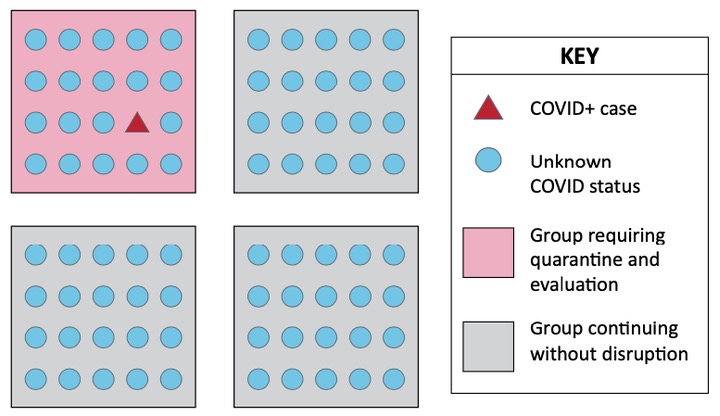The situation is somewhat fluid, as we said.
When I began this editorial series a few days ago, the Denver Public Schools were planning to start the school year with ‘distance learning’ — children staying home and connecting with their class via the Internet — for the first couple of weeks of the 2020-201 school year. The district would then determine whether it was safe to bring students back into the classrooms.
Exactly what “safe” means, is not entirely clear. Bringing people into indoor spaces during a coronavirus pandemic entails an element of risk, for both workers and clients. How much risk are we willing to take?
Yesterday, however, DPS announced that their schools will conduct teaching remotely through at least October 16. District officials are working with public health officials on a framework that would allow students to return to the classroom. We assume the district is also working with staff?
That decision seems to fly in the face of the Republican agenda as expressed in Washington DC. From a July 27 story on the Chalkbeat.org website, by reporters By Matt Barnum and Sarah Darville:
For several weeks, President Trump has said that schools that didn’t reopen their buildings this fall could risk losing funding.
Now, Senate Republicans have introduced a mechanism to make that a reality.
Their bill, which kicks off a final round of negotiations over an additional coronavirus stimulus package, includes $70 billion for K-12 public and private schools. But two-thirds of that money would only be accessible to schools if they offer some in-person instruction — something that schools in many parts of the country have decided is unsafe to do for now.
For example, Denver Public Schools, it would appear.
The Republican lawmakers in Washington understand that the US economy will continue to be hampered if parents are staying home from work to supervise their own children.
National surveys of parents, however, show that most remain wary of their children returning to schools while the country struggle to control the current coronavirus surges in many states. The Centers for Disease Control and Prevention warned last week that schools in “hot spots” may find it unwise to reopen their schools.
Democrats in Washington have thus far opposed tying funds to reopening of buildings, and education groups immediately criticized the Republican proposal, which was released Monday.
From the July 27 Chalkbeat article:
“We are deeply concerned that the bill would seek to tie much-needed assistance to a federal definition of school building reopening. Student health and safety is the most local of concerns,” said Carissa Moffat Miller, executive director of the Council of Chief State School Officers.
As we’ve discussed, public education has long been treated as a ‘local issue’ — as Ms. Moffat Miller here reminds us. Even the slow and seemingly inexorable consolidation of political power by the federal government over the past 230 years has allowed public schools to be managed mainly by local school boards. Yes, federal rules apply to certain types of education funding, and local school budgets have become to some degree dependent upon that federal funding.
Meanwhile, the growth of teachers unions since the 1950s has provided a challenge to state and federal bureaucrats. The influence of those unions is felt — by default — even in small towns like Pagosa Springs, where the teachers association has very limited power, but where important statewide decisions being made in Denver are influenced by union lobbying.
WE can assume, for example, that Denver Public School’s decision to remain outside the school building until October 16 was likely made with input from the Colorado Education Association, a voluntary organization that includes 35,000 public school employees.
Here in Pagosa, it would appear that all our public school buildings will be welcoming students, come September 8. (Did I mention, the situation is fluid?) The schools — including the charter school — plan to keep the students in ‘cohorts’ so that a potential infections will be limited in their spread.

Families who are uncomfortable sending their children into a school building at this point will be provided some type of online learning option. Exactly what that looks like is not yet clear to me.
When I sat down with Pagosa Peak Open School’s School Director, Angela Reali-Crossland, last week, I wondered about how PPOS would be dealing with “specials” — the classes like music, art, PE and Spanish that are sometimes treated as ‘educational frills’.
Obviously, those subjects are challenging to provide via the Internet, to families who choose to keep their kids at home. Will they also be challenging inside a building that is operating with ‘cohorts’?
“We value the specials and having a well-rounded education, and so music and art and PE are valuable to us — and Spanish as well,” Ms. Reali-Crossland explained. “So we want to continue to provide those for our students, whether in-person or distance learning option.
“We will have outdoor areas here at PPOS where those classes could take place, and sanitation wouldn’t be as big of a deal. We’re also looking at the other option, of having the specialist teachers pushing into the classroom, and they would be one of the three or four adults who would be allowed to teach that cohort each day.
“Or we could have the students have art in an art room and have that room sanitized between cohorts.”
Lord knows, we could all use a bit of music and singing right about now.

